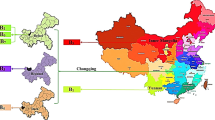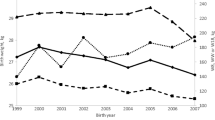Abstract
Assessment of genetic diversity is a prerequisite for the management and conservation of animal genetic resources. Appropriate design of breeding programmes is therefore impossible for breeds that have not been adequately characterized either phenotypically and/or genetically. Phenotypic characteristics are important in breed identification and classification in ways that farming communities can relate with. This study phenotypically characterized two breeds of zebu cattle in Kenya. A total of 12 measurements (face length, ear length, horn length, heart girth, height at withers, chest depth, body length, height at rump, pelvis width, corpus length, pin bone width and tail length) were collected on 373 Maasai and 277 Kamba zebu kept by traditional farmers in south-east Kenya. The data were classified on the basis of breed group, age group, sex and coat colour pattern. Breed group, age group and sex significantly influenced all measurements. Coat colour pattern significantly influenced only height at withers, corpus length, ear length and tail length. Except for horn and ear length, all the other measurements were significantly higher for the Maasai zebu. Additionally, the Maasai zebu was taller than it was long. The opposite was true for the Kamba zebu. The Maasai and Kamba zebus can be classified as medium-sized breeds; however, great variations exist in their body sizes within and between the breeds.
Similar content being viewed by others
Abbreviations
- BL:
-
body length
- CD:
-
chest depth
- CL:
-
corpus length
- EL:
-
ear length
- FL:
-
face length
- HG:
-
heart girth
- HRP:
-
height at rump
- HL:
-
horn length
- PW:
-
pelvis width
- PBW:
-
pin bone width
- SEAZ:
-
small East African Shorthorn Zebu
- TL:
-
tail length
- HW:
-
height at withers
References
Aboagye, G.S., Tawah, C.L. and Rege, J.E.O., 1994. Shorthorn cattle of West and Central Africa III: Physical, adaptive and special genetic characteristics. World Animal Review, 78(1), 22–32
Alderson, G.L.H., 1999. The development of a system of linear measurements to provide an assessment of type and function of beef cattle. Animal Genetic Resources Information, 25, 45–56
Brotherstone, S. and Hill, W.G., 1991. Dairy herd life in relation to linear type traits and production 1: Phenotypic and genetic analysis in pedigree type classified herds. Animal Production (UK), 53, 279–287
Butterworth, M.H. and McNitt, J.I., 1984. The Malawi Zebu. World Animal Review, 49, 6–12
Buvanendran, V., Umoh, E.J. and Abubakar, B.Y., 1980. An evaluation of body size as related to weight of three West African breeds of cattle in Nigeria. Journal of Agricultural Science (Cambridge), 95, 219–224
Coleman, S.W. and Evans, B.C., 1986. Effect of nutrition, age and size on compensatory growth in two breeds of steers. Journal of Animal Science, 63, 1968–1982
Ebangi, A.L. and Vall, E., 1998. Phenotypic characterisation of draft donkeys within the Sudano-Sahelian zone of Cameroon. Revue d'Élevage et de Médecine Vétérinaire des Pays Tropicaux (Paris), 51(4), 327–334
Fernandez, G., Baro, J.A., de la Fuente, F.L. and San Primitivo, F., 1997. Genetic parameters for linear udder traits of dairy ewes. Journal of Dairy Science, 80, 601–605
Gatesy, J. and Arctander, P., 2000. Hidden morphological support for the phylogenetic placement of Pseudoryx ngetinhensis with bovine bovids: a combined analysis of gross anatomical evidence and DNA sequences from five genes. Systematic Biology, 49(3), 515–538
Goe, M.R., Alldredge, J.R. and Light, D., 2001. Use of heart girth to predict body weight of working oxen in the Ethiopian highlands. Livestock Production Science, 69(2), 187–195
Hall, S.J.G., 1991. Body dimensions of Nigerian cattle, sheep and goats. Animal Production (UK), 53, 61–69
Jaetzold, R. and Schmidt, H., 1983. Farm Management Handbook of Kenya: Vol. IIC, East Kenya, Vol. IIB, Central Kenya: Natural conditions and farm management information, (Ministry of Agriculture, Nairobi, Kenya)
Kamalzadeh, A., Koops, W.J. and van Bruchem, J., 1998. Feed quality restriction and compensatory growth in growing sheep: modelling changes in body dimensions. Livestock Production Science, 53, 57–67
Lawrence, T.L.J. and Pearce, J., 1964. Some effects of wintering beef cattle on different planes of nutrition I: Live weight gain, food consumption and body measurement changes during the winter period and the subsequent grazing period. Journal of Agricultural Science (Cambridge), 63, 5–20
Luo, M.F., Wiggans, G.R. and Hubbard, S.M., 1997. Variance component estimation and multitrait genetic evaluation for type traits of dairy goats. Journal of Dairy Science, 80, 594–600
Mason, I.L., 1996. A World Dictionary of Livestock Breeds, Types and Varieties, 4th edn, (CAB International, Wallingford, UK)
Okeyo, A.M., Mosi, R.O., Ahuya, C.O., Rege, J.E.O. and Okomo, M.A., 1996. Phenotypic characteristics of the small East African zebu cattle in the Lake Victoria basin and coastal lowlands of Kenya: morphological and physical characteristics. In: P.O. Mbandi and R.O. Sitawa-Ogutu (eds), Proceedings of the 5th KARI Scientific Conference 14–16 Oct. 1996, KARI Headquarters, Nairobi, Kenya), 345–355
Okomo, M.A., 1997. Characterisation of the genetic diversity of East African cattle breeds by microsatellite DNA analysis, (MSc thesis, University of Nairobi)
Rege, J.E.O., 1999. The state of African cattle genetic resources I: Classification framework and identification of threatened and extinct breeds. Animal Genetic Resources Information, 25, 1–25
Rege, J.E.O., 2001. Defining livestock breeds in the context of community-based management of farm animal genetic resources. In: Proceedings of a Workshop on Community-based Management of Animal Genetic Resources – A Tool for Rural Development and Food Security, Mbabane, Swaziland, 2001, (FAO, Rome), 27–35
Rege, J.E.O. and Gibson, J.P., 2003. Animal genetic resources and economic development: issues in relation to economic valuation. Ecological Economics, 45, 319–330
SADC (South African Development Co-operation)/ILRI (International Livestock Research Institute). Animal Genetic Resources Survey Colour Chart, 2001, (ILRI, Nairobi, Kenya)
SAS, 2003. SAS Users Guide for Personal Computers, Statistical Programme, release 8.01 Windows Version 4.10.2222, (SAS Institute Inc., Cary, NC)
Schmidt, P.J. and Yeates, N.T.M., 1985. Beef Cattle Production, 2nd edn, (Butterworths, Sydney)
Zechner, P., Zohman, F., Solkner, J., Bodo, I., Habe, F. and Marti, E., 2001. Morphological description of the Lipizzan horse population. Livestock Production Science, 69(2), 163–177
Author information
Authors and Affiliations
Corresponding author
Rights and permissions
About this article
Cite this article
Mwacharo, J.M., Okeyo, A.M., Kamande, G.K. et al. The small East African shorthorn zebu cows in Kenya. I: Linear body measurements. Trop Anim Health Prod 38, 65–74 (2006). https://doi.org/10.1007/s11250-006-4266-y
Accepted:
Issue Date:
DOI: https://doi.org/10.1007/s11250-006-4266-y




